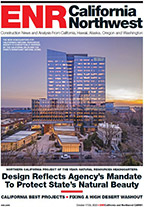High-speed rail advocates are looking on the bright side after new California Gov. Gavin Newsom declared In his first State of the State speech this month that the $77-billion planned San Francisco-Los Angeles system was ballooning out of control in costs.
Newsom said he will focus on completion of the first 171 miles between Merced and Bakersfield.
The California High-Speed Rail Authority is facing a self-reported cost increase, to $77.3 billion from $67 billion, plus a four-year schedule delay, to 2033.
CEO Brian Kelly released a statement: “The Governor has called for setting a priority on getting high speed rail operating in the only region in which we have commenced construction—the Central Valley. We are eager to meet this challenge and expand the project’s economic impact in the Central Valley."
Kelly added that "Importantly, [Newsom] also reaffirmed our commitment to complete the environmental work statewide, to meet our 'bookend' investments in the Bay Area and Los Angeles and to pursue additional federal and private funding for future project expansion. We welcome this direction and look forward to continuing the important work on this transformative project.”
Rick Harnish, executive director of the Midwest High Speed Rail Association, says the narrowed focus could be of long-term benefit to the broader goal of connecting the Bay Area and Southern California. “If they could really focus on 220-mph trains between Merced and Bakersfield and fix connectors at both ends, that alone would be transformative. What if you upgrade Amtrak service from Oakland to Merced and Merced to Sacramento and add a couple of trains a day? Now you’ve got Bay Area to Central Valley in auto-competitive time.”
Some $3 billion in construction is underway.
The first segment, CP1, covering 32 miles from Madera to Fresno, has passed the 50% mark and has 33 major structures, including two trenches and three viaducts.
On the 65-mile CP2-3 segment, design is almost complete and more than half of 850 parcels have been acquired, but the spring 2020 deadline will be pushed back, say officials.
The 21-mile CP4 extending north has begun initial construction while the agency starts to wrap up environmental permits
The American Public Transportation Association also took an optimistic approach, stating that it “appreciates and applauds ... Newsom's commitment to the long-term goal of bringing high-speed rail to California and to continued improvements of local and regional public transportation systems. The Governor said that the state will focus first on completing the 119-mile Central Valley phase in the near term, while completing environmental assessments and seeking funding for the entire project."
It added that "investments made to date have created thousands of jobs and will produce dramatic improvements in mobility through clean, efficient public transportation."



Post a comment to this article
Report Abusive Comment